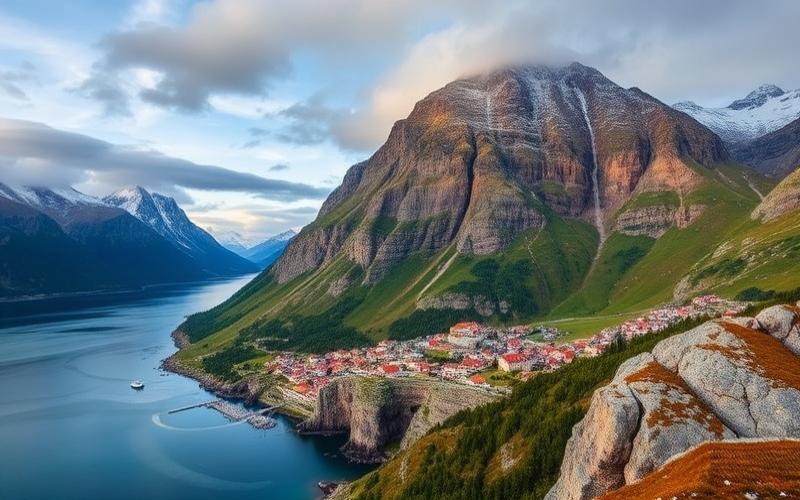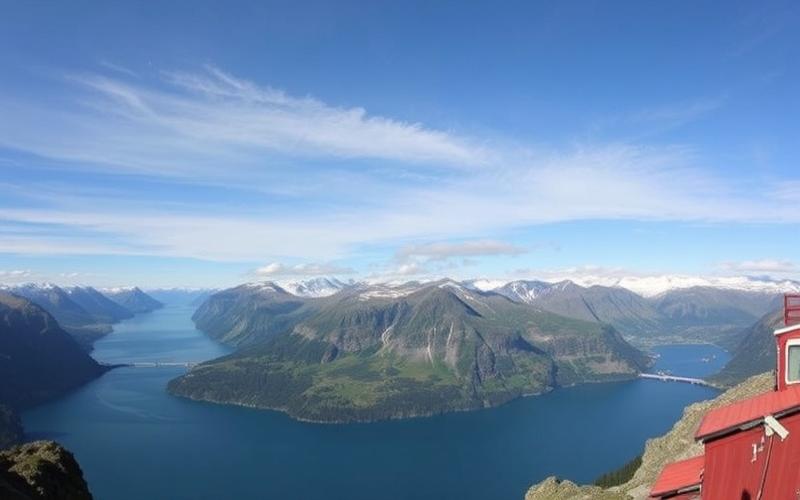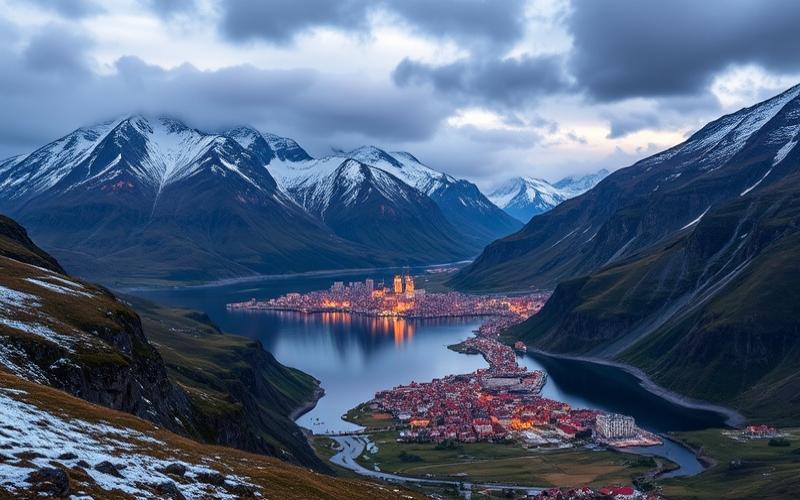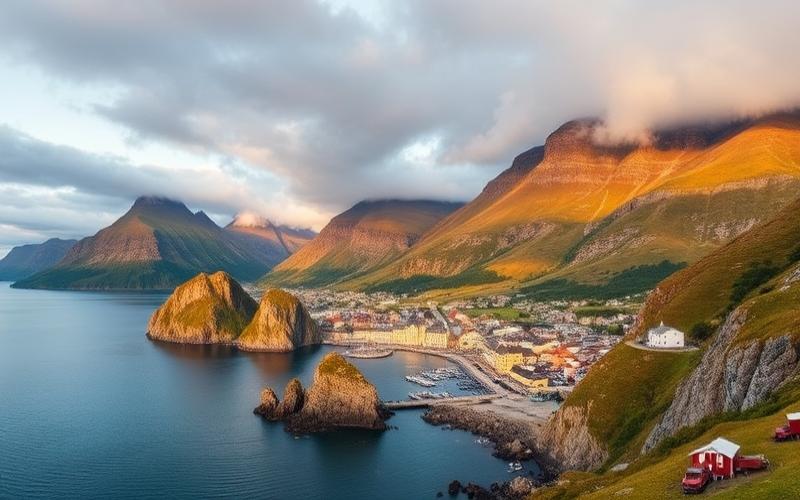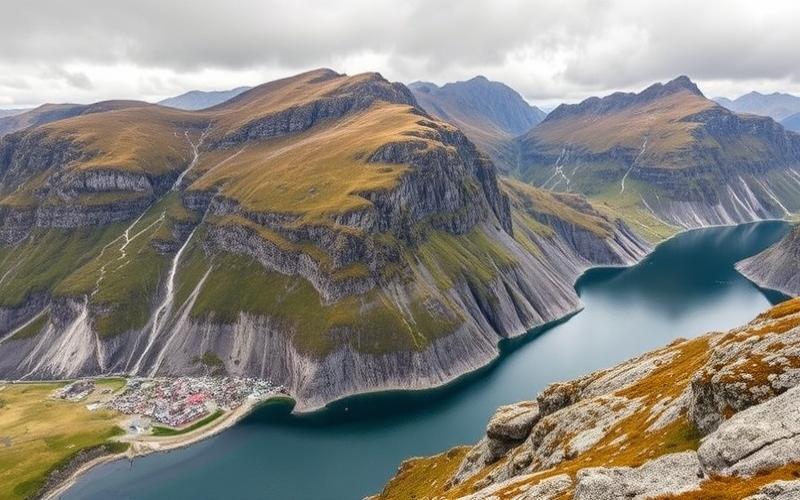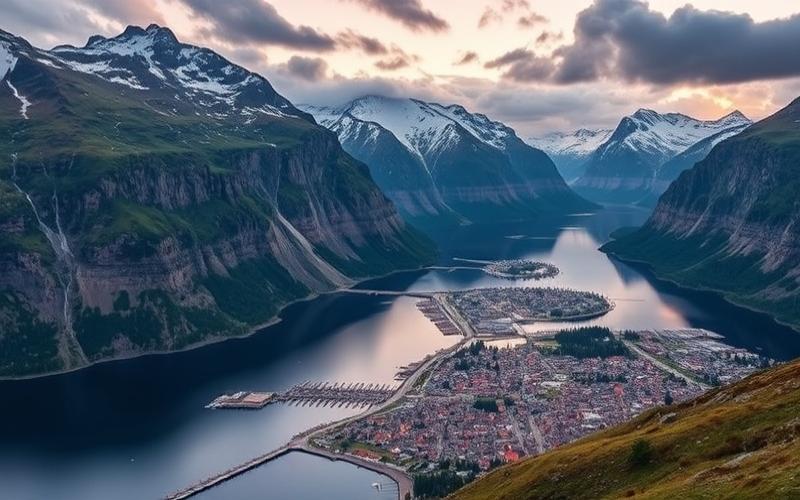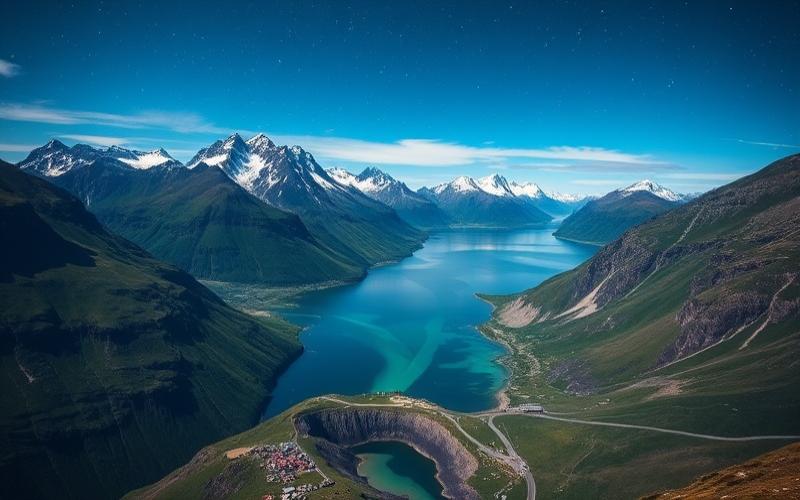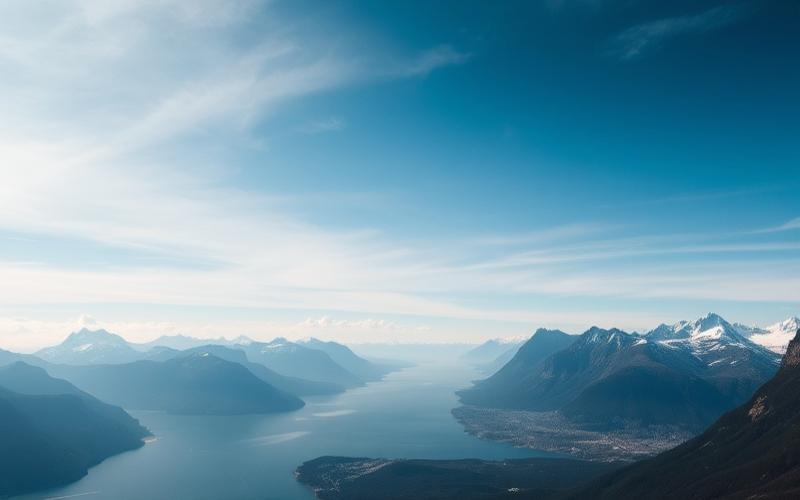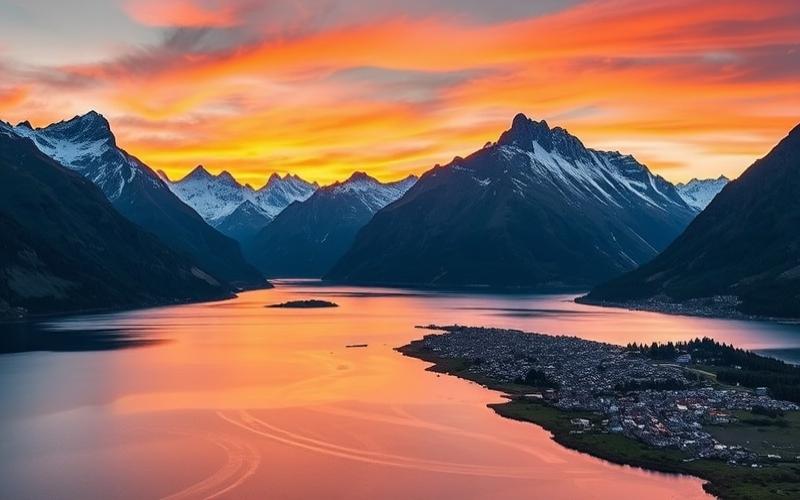
 Published on and written by Cyril Jarnias
Published on and written by Cyril Jarnias
Living in Norway presents a unique set of climate challenges that can surprise even the most experienced expats. With its harsh winters, endlessly stretching summer days, and the magic of the Northern Lights, this country offers a living environment that is both enchanting and demanding.
Adapting to the Norwegian climate isn’t just about ensuring your wardrobe is well-equipped; it also involves understanding cultural nuances related to the weather, such as the importance of the art of “hygge” for creating a cozy atmosphere despite snowstorms.
In this article, discover practical and essential tips to blend into your Norwegian environment and turn these climate challenges into an integral part of your new daily life.
Dressing for the Norwegian Cold
Adapting to the variable temperatures of the Norwegian climate relies on the three-layer rule. This method involves layering different types of clothing, each with a specific function:
- First layer: Merino wool or synthetic thermal underwear, which retains heat and wicks away body moisture.
- Second layer: Fleece or wool, which provides excellent thermal insulation even in wet conditions.
- Third layer: Waterproof jacket (Hardshell or Softshell type), essential for protection from rain, wet snow, and wind.
Layering allows you to quickly adjust your outfit based on temperature changes or activity level, ensuring warmth, comfort, and breathability.
Recommended Materials:
- Merino wool: retains heat even when wet, dries quickly, and doesn’t hold odors.
- Fleece: lightweight, warm, breathable, ideal as a second layer.
- Technical textiles: prioritize those offering both insulation and breathability to limit sweating and moisture.
Essential Accessories:
- Beanie: wool or fleece for optimal head insulation.
- Gloves/mittens: down mittens or waterproof ski gloves protect better against extreme cold; wool liners recommended.
- Scarf or face mask: covers the face against icy wind.
- Socks: Norwegian wool or mohair, thick and breathable.
- Gaiters: to prevent snow from getting into boots.
Suitable Footwear:
- Hiking or ski boots: prioritize waterproof models with non-slip soles and insulated lining.
- Waterproofing: essential to withstand wet snow, puddles, and ambient humidity.
Tips for Buying Technical Clothing:
- Choose specialized outdoor clothing brands: Odlo, Norveg, Icewear, or visit local sports stores (XXL, Sport1, Intersport).
- Check for labels guaranteeing waterproofing (Gore-Tex, Softshell), breathability, and thermal resistance.
- Norwegian stores often offer models adapted to the local climate; staff can advise based on planned activities.
Waterproofing is a non-negotiable criterion for facing the frequent rains and wet snow of the Norwegian climate.
| Function | Recommended Material | Example Accessory | Key Criterion |
|---|---|---|---|
| First Layer | Merino Wool, Synth. | Thermal Underwear | Moisture Management |
| Second Layer | Fleece, Wool | Sweater, Fleece | Thermal Insulation |
| Third Layer | Softshell, Hardshell | Waterproof Jacket | Rain/Snow Protection |
| Feet | Wool, Mohair | Socks, Boots | Warmth, Waterproofing |
| Head/Hands | Wool, Fleece, Down | Beanie, Gloves, Mittens | Insulation, Waterproofing |
- Plan for multiple pairs of socks and gloves to alternate and ensure extremities stay dry and warm.
- Quality over quantity: fewer layers but high-performance technical clothing is better.
In Norway, there’s no such thing as bad weather, only unsuitable clothing.
Good to Know:
Opt for layered clothing with wool and fleece for warmth, complemented by accessories like beanies and gloves; prioritize waterproof shoes to face snow and humidity. Specialized Norwegian stores offer a wide range of technical clothing combining insulation and breathability.
Tips for Preserving Your Health in the Local Climate
Low temperatures and high humidity in Norway can cause an intense feeling of cold, increase the risk of hypothermia, frostbite, and promote the onset of seasonal respiratory illnesses like colds or flu. Humidity accentuates the feeling of cold and can worsen joint or muscle pain, especially in sensitive individuals.
Effects of the Norwegian Climate on Health:
- Drop in body temperature (hypothermia) with prolonged exposure without protection.
- Increased risk of respiratory infections.
- Heightened fatigue related to lack of sun in winter.
- Risk of slipping on black ice and associated injuries.
Common Seasonal Illnesses:
- Cold
- Flu
- ENT Infections
Prevention and Care:
- Update recommended vaccines (flu, DTP, whooping cough, measles, hepatitis).
- Regular hand washing to limit virus transmission.
- Regular medical check-ups, especially with unusual symptoms after a stay.
Diet and Vitamin D:
Low sun exposure in winter limits natural vitamin D synthesis. It’s therefore important to adopt a diet rich in:
- Fatty fish (salmon, mackerel)
- Fortified dairy products
- Eggs
- Vitamin D supplements if necessary, on medical advice
Adapted Clothing Habits:
| Principle | Example of Recommended Clothing |
|---|---|
| Layering | Thermal underwear, wool sweater, windproof jacket, puffer coat |
| Materials | Wool (insulation and moisture management), technical fibers |
| Accessories | Beanie, gloves, scarf, thick socks, waterproof boots |
- The layering technique allows adjusting body heat according to activity and weather.
- Wool clothing stays warm even when wet and regulates sweat well.
Physical Activity and Well-being:
- Regular physical activity (walking, skiing, snowshoeing, indoor swimming) strengthens the immune system and improves mood.
- Even in cold weather, exercise contributes to stress management, sleep regulation, and maintaining good energy levels.
Managing Climate and Cultural Stress:
- Take time to adapt to the Norwegian rhythm, often calmer and nature-focused.
- Learn about local customs to better understand the social environment.
- Practice relaxation, meditation, or join expat groups or activity clubs to break isolation.
Preventive Care to Prioritize:
- Annual flu vaccination
- Tick-borne encephalitis vaccine in rural areas or for hiking enthusiasts
- Annual medical check-up, especially for at-risk individuals or those with chronic illness
- European Health Insurance Card for access to healthcare in Norway
Key Takeaways:
Adopt a diet rich in vitamin D, practice regular physical activity, wear suitable layered clothing, stay up-to-date with vaccinations, and consult a healthcare professional regularly to preserve your well-being against the Norwegian climate.
Good to Know:
Wear wool clothing and layer them to better manage body heat against the Norwegian cold, and prioritize a diet rich in vitamin D to compensate for the lack of sun. Sign up for seasonal vaccines and have regular medical check-ups to prevent colds or flu.
Adapting and Organizing Daily Life to Local Seasons
Understanding Norwegian Seasons
Norway is distinguished by very marked seasons, influenced by its latitude. In winter, especially in the north, the polar night (mørketid) sets in: the sun disappears completely from the horizon for several weeks, plunging the region into near-permanent darkness. Conversely, summer brings the midnight sun phenomenon (midnattssol) where the sun never sets in Arctic areas, offering up to 24 hours of light. These phenomena deeply shape local life, fostering introspection and indoor activities in winter, and a very active social life in summer thanks to the abundance of light.
| Seasons | Particularities | Impact on Lifestyle |
|---|---|---|
| Winter (Dec.-Mar.) | Polar night, cold, abundant snow | Indoor activities, slower pace, valuing comfort |
| Summer (June-Aug.) | Midnight sun, mild temperatures | Outdoor activities, intense social life, outdoor leisure |
| Spring/Autumn | Rapid transitions, variable weather | Daily adaptation, changing leisure and clothing |
Organizing Daily Life in Winter
- Anticipate extreme conditions: plan for thermal clothing, insulated boots, and adapted equipment (snow shovels, winter tires).
- Maximize artificial light: install full-spectrum lamps, multiply light sources at home, use dawn simulation alarm clocks.
- Monitor vitamin D: consume rich foods (fatty fish, eggs), and if necessary, take supplements to compensate for lack of sun exposure.
- Plan travel: account for reduced schedules, snowy roads, and anticipate delays due to climate.
Seasonal Activities
- Winter: cross-country skiing, alpine skiing, snowshoeing, ice fishing, Northern Lights viewing, hygge evenings at home.
- Spring: hiking, observing snowmelt and waterfalls, nature outings to see reawakening wildlife.
- Summer: hiking, kayaking, lake swimming, surfing, fjord cruises, festivals and outdoor gatherings.
- Autumn: forest walks to admire colors, mushroom and berry picking, preparing the home for winter.
Lifestyle and Home
- Optimize thermal comfort: install underfloor heating, use thick rugs, reinforce window insulation.
- Choose suitable clothing: layering, waterproof and breathable clothes, functional accessories like beanies and gloves.
- Arrange the interior: create cozy spaces with cushions, blankets, warm lighting, and dedicated relaxation areas (innekos).
- Plan spaces for drying and storing wet or snowy clothes.
Routine and Well-being
- Maintain a regular rhythm: wake up and go to bed at fixed times to stabilize the biological rhythm despite light variations.
- Practice physical activities: winter sports or home exercises to combat sedentariness and winter blues.
- Participate in social life: organize dinners, join clubs or associations, discover local festivals.
- Adapt your diet: prioritize local seasonal products, energy and vitamin-rich dishes, draw inspiration from traditional Norwegian cuisine.
Social Interaction
In winter, the culture of hygge and innekos encourages inviting people home, organizing cozy evenings, and strengthening family and friendship bonds. In summer, outdoor gatherings are preferred: picnics, barbecues, neighborhood parties, group hikes. Seasons influence cultural habits: valuing community in winter, openness and discovery in summer.
| Season | Type of Social Interaction | Cultural Habits |
|---|---|---|
| Winter | Home evenings, small groups | Hygge, sharing, introspection |
| Summer | Outdoor gatherings, festivals | Openness, exploration, conviviality |
| Intermediate | Mixed activities, adaptation | Transition, nature discovery |
Key Takeaway: Adapting your daily life to Norwegian seasons requires flexibility, anticipation, and creativity to fully enjoy each period while preserving your physical and mental well-being.
Good to Know:
In Norway, the polar winter requires integrating artificial light sources and ensuring sufficient vitamin D intake, while summer invites enjoying the midnight sun for outdoor activities like kayaking. For optimal comfort, arrange your interior with underfloor heating and adapted windows, and adopt functional clothing for varied climate conditions.
Essentials for Living in Norway
To face the Norwegian climate, it’s essential to equip yourself with clothing and gear specifically designed to withstand cold, humidity, and snow.
Indispensable Clothing for the Norwegian Climate:
- Thermal underwear (ideally merino wool or synthetic fibers) for optimal insulation.
- Waterproof and breathable jackets like Gore-Tex, with sealed seams to prevent moisture penetration.
- Waterproof pants or ski pants adapted to inclement weather.
- Puffer coats or warm fleece jackets for breaks or extreme cold.
- Thick wool socks to keep feet dry and warm.
- Gloves or windproof mittens, preferably lined with wool or fleece.
- Warm beanie covering the ears.
- Scarf, neck gaiter, or buff to protect the throat and face.
- Ice cleats for shoes or non-slip overshoes, very useful on ice.
Suitable Footwear:
- Hiking or snow boots with high tops, waterproof, with lugged soles and thermal insulation.
- For sports activities (skiing, snowshoeing), choose technical footwear adapted to the activity.
Essential Accessories:
- Gloves, scarves, beanies: prioritize breathable and warm materials.
- Ice cleats for shoes: indispensable in the city or hiking to avoid falls on black ice.
- Gaiters to prevent snow from entering shoes.
Home Equipment:
- Window insulation (plastic film, door draft stoppers) to limit heat loss.
- Supplementary heating appliances (electric radiators, fan heaters) to complement central heating.
- Humidifier to avoid overly dry air from heating.
Equipment for Outdoor Activities (Hiking, Skiing):
| Activity | Recommended Technical Equipment | Specific Advice |
|---|---|---|
| Ski Touring | Adapted skis, climbing skins, avalanche transceiver, shovel, probe, helmet, poles, crampons, ice axe | Prioritize lightweight, warm, robust gear. |
| Winter Hiking | Poles, snowshoes/crampons, backpack | Pack a first aid kit, headlamp, thermos, survival blanket. |
| Long-Duration Trek | 4-season tent, insulating sleeping pad, extreme cold sleeping bag | Avoid cotton, which retains moisture. |
Where to Buy This Equipment:
- Specialized mountain stores: Hardloop, Au Vieux Campeur, Décathlon (for entry-level).
- Outdoor shops in Norway: XXL, Sport 1, Anton Sport.
- Specialized online sites: Aventurenordique, Snowleader, Bergfreunde.
Sale Periods for Savings:
- Winter sales: January-February, ideal for buying thermal clothing and ski gear.
- Summer sales: July-August, good deals on hiking equipment and previous season models.
- Black Friday (late November) and occasional promotions on specialized sites.
Reputable Brands:
- Clothing: Norrona, Arc’teryx, Patagonia, The North Face, Millet.
- Footwear: Meindl, Salomon, Scarpa, La Sportiva.
- Accessories and Gear: Black Diamond, Petzl, Leki, Thermarest.
Tips for Maintaining Your Gear Durably:
- Wash technical clothing at low temperature, without fabric softener, to preserve fibers.
- Re-waterproof regularly jackets and pants (spray or special detergent).
- Air dry shoes, away from direct heat sources.
- Sharpen and maintain crampons and other metal equipment to prevent rust.
- Store gear in a dry and ventilated place, protected from humidity.
Properly equipping and maintaining your gear not only allows you to fully enjoy activities in Norway but also ensures safety, comfort, and durability.
Good to Know:
To face the Norwegian climate, invest in thermal clothing, waterproof jackets, and snow-adapted shoes; Norwegian brands like Bergans and Helly Hansen offer durable options. Accessories like gloves, beanies, and ice cleats are essential, and for sales, prioritize winter periods in stores like XXL and Intersport; also consider insulating your home with double-glazed windows and supplementary heating appliances.
Disclaimer: The information provided on this website is for informational purposes only and does not constitute financial, legal, or professional advice. We encourage you to consult qualified experts before making any investment, real estate, or expatriation decisions. Although we strive to maintain up-to-date and accurate information, we do not guarantee the completeness, accuracy, or timeliness of the proposed content. As investment and expatriation involve risks, we disclaim any liability for potential losses or damages arising from the use of this site. Your use of this site confirms your acceptance of these terms and your understanding of the associated risks.


